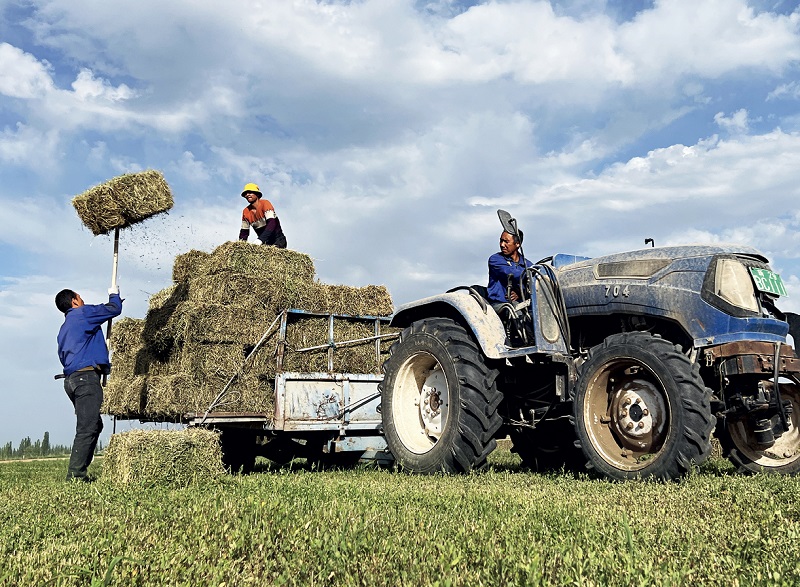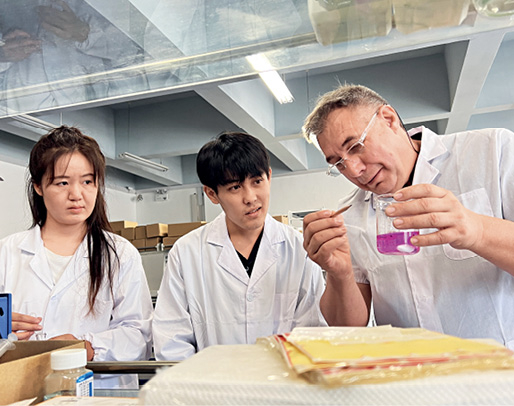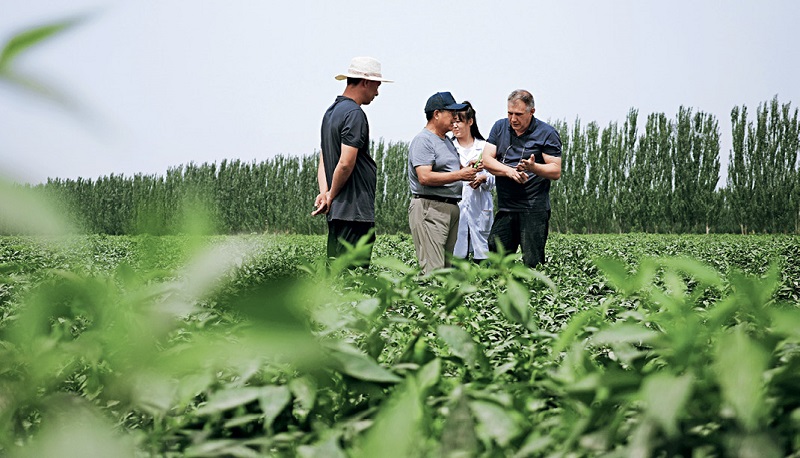For Decombel Danny Camiel, Xinjiang is not only a place of opportunity where he started his agricultural career, but also his home away from home.

Cattle farm employees are hauling forage reserves for winter consumption. Baowei
“It was a good decision to set up a business in Xinjiang. I don’t think any place other than Xinjiang could have given me such an opportunity,” said Decombel Danny Camiel, a 59-year-old Belgian who runs a fertilizer company and breeds cattle in northwest China. For him, Xinjiang is not only an enjoyable place to live, and somewhere which has given him the chance to launch his career, but also is his home away from home.
Early Days in Xinjiang
Growing up along the Belgium coast, Camiel never thought he would ever make a life in China, especially in Xinjiang. It all started in 1986, the year he graduated from university with an agricultural engineering degree. At that time, his dream was to find work in a developing country. At the end of his studies, the rector of his university called him into his office and informed him of a job opportunity in a feed additive company in Shenzhen, China. He applied for and got the job, but had to undergo training that lasted until January 1988, before finally being able to travel to China.
China at that time was at the beginning of its reform and opening-up drive, and on his arrival the young Belgian was amazed to see the frenzy of construction in Shenzhen. He remembers that there was no telephone in the office, no highway or airport, and the narrow road from Shenzhen to Guangzhou was always gridlocked.
During the following years however, the city changed before his eyes at an incredible pace: installation of IDD (International Direct Dialing) telephone lines, Internet connection, opening of a highway to Guangzhou and commissioning of an airport. “The once small fishing village has been transformed into what is now the factory of the world. I had never experienced such spectacular economic development,” recalled Camiel.
He has since worked in several Chinese cities: Guangzhou, Quanzhou, and Tianjin, always in the agricultural sector. This experience allowed him to learn more about China and its development. He also met his wife in Fujian Province, and the couple now have a daughter and a son.
In the year 2000, Camiel was hired by Kemira, a European fertilizer company based in Finland, which opened a branch in Zhanjiang, Guangdong Province. At the time, Kemira was a world leader in water-soluble acid fertilizers used for irrigation in dry areas. In China, Kemira’s main market was in Xinjiang, where drip irrigation technology had been widely adopted. From 2001, Camiel was put in charge of the business operation in Xinjiang.
Change came abruptly in 2005, when Kemira chose to leave the fertilizer business, and Camiel found himself unemployed. After careful consideration, he decided to take the plunge and start a business producing water-soluble acid fertilizers in Xinjiang. “The land area in Belgium and even in Europe is quite limited, and opportunities are scarce, but Chinese agriculture still has great potential,” said Camiel. “In addition, drip irrigation technology has been widely adopted in Xinjiang, which means there is a huge demand for water-soluble fertilizers.”

Camiel and his colleagues performing an experiment. Baowei
Fertilizer and Cattle Opportunities
In 2005, he visited many farmers in northern Xinjiang and told them about the effects of water-soluble fertilizers. He found that his ideas were widely accepted. In 2006, he set up a fertilizer company in Shawan County, northern Xinjiang.
The company hired a team of agricultural graduates and trained them in all aspects of improving saline land, plant nutrition, and irrigation planning. Customers recognized the benefit of water-soluble acid fertilizers quickly and the company was successful in northern Xinjiang. However, Camiel has since encountered challenges in the region’s south.
“Many farmers in southern Xinjiang had not yet started using drip irrigation technologies when I planned to expand my business in 2011,” he said. In addition, fertilizers that were suitable for land in northern Xinjiang were not suitable for land in southern Xin-jiang due to different soil types.
After conducting long and intensive laboratory research, his team finally discovered the correct fertilizer formula.
Along with the right product, Camiel also attaches great importance to the quality of his company’s services. He has introduced rapid field petiole analysis for many crops, which optimizes the fertilization schedule, saves input costs for the farmer, and increases harvests. Through his efforts, the company has grown from one production base to four, currently operating across Xinjiang. It now sells 20,000 tonnes of fertilizer per year, which is used on about 67,000 hectares of farmland in the region.
In 2017, Camiel expanded his business to raise cattle. He introduced the Belgian White-Blue (BWB) cattle breed to China. Hybridization with local beef cattle produces offspring that can greatly increase meat yields, and the good connection he has built with local farmers has helped with the introduction of the breed.
“The BWB is a treasure of our country. As with any innovation, acceptance by breeders takes time and effort, but the feasibility and economic returns of using bulls of this breed in a crossbreeding program are obvious, and I am sure that the BWB will find its place in the rapid development of the beef cattle trade in China,” he said.

Camiel and his colleagues conducting crop and soil research. Chen Zhe
Witnessing Agricultural Modernization
Living and working in Xinjiang since 2005, Camiel and his wife are comfortable in the community. Their two children have gone through local primary and secondary schools and have fit in well with their classmates.
Being curious of the place around him, the Belgian entrepreneur is able to observe the economic and social development of this region on a daily basis. “My work takes me to the most remote villages, where I witnessed how rapid economic and social development has raised the living standard of the inhabitants,” he said.
As an entrepreneur in the fertilizer sector, Camiel has extensive contact with local cotton producers and is impressed by their agricultural modernization. He finds it hard to understand the fake news reports that circulate among Western media about “forced labor” in Xinjiang.
According to Camiel, the mechanization of cotton cultivation began very early in Xinjiang. In 2005, American cotton harvesters manufactured by John Deere and Case were already there, although manual cotton picking was still widespread. With the ever-increasing cost of labor and the difficulty of managing large groups of cotton pickers, the use of the cotton harvester has become increasingly advantageous in Xinjiang. In 2012, most of Camiel’s fertilizer customers in northern Xinjiang relied on these machines. By 2017, only fields that were too small or those where access was limited by power lines or narrow dirt roads continued to rely on hand pickers, at a much higher cost. The manual picking area is in fact very small when compared to the entire Xinjiang crop yield. “Presenting the cotton harvest in Xinjiang as still manual picking through ‘forced labor’ is a statement I cannot understand. That’s just not what I’ve witnessed year after year,” said Camiel.